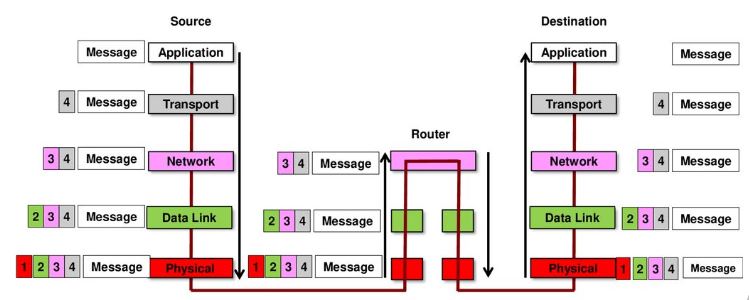Data Encapsulation in Computer Networks | Encapsulation Vs Decapsulation
This article is describe Data Encapsulation in Computer Networks. In order to understand the process of data encapsulation , you should aware with terms message segmentation and protocol data units (PDUs).What is MESSAGE SEGMENTATION?
When a message is sent over the computer network from a source to a destination, it is done through a massive and continuous transmission of bits. This means that no other device can send or receive messages on the same network while this data transfer is in progress, which causes significant delays. In addition, if a link fails in the infrastructure of the interconnected network during transmission, the entire message would be lost and would have to be re-transmitted completely. Then it is better to divide the data into smaller and more manageable parts to send them over the network. This division is called segmentation and has both advantages and disadvantages:- Advantages: By sending smaller individual parts from the origin to the destination, various conversations can be interleaved in the network, called multiplexing . Segmentation can increase the efficiency of network communications, that is, if part of the message fails to reach the destination due to a network failure or congestion, only missing parts must be re-transmitted.
- Disadvantage: Level of complexity that is added to the process.
What is PDU (PROTOCOL DATA UNITS)?
The Protocol Data Units (PDUs) describe a portion of data in any layer of a network model:- Data: General term used in the application layer for the PDU
- Segment: Transport layer PDU
- Package: Network Layer PDU
- Frame: PDU of the data link layer
- Bits: physical layer PDU that is used when data is physically transmitted through the medium
ENCAPSULATION AND DECAPSULATION PROCESS
Encapsulation process :
When messages are sent on a network, the encapsulation process operates from the upper layers to the lower layers. In each layer, the information in the upper layer is considered as data in the encapsulated protocol. For example, the TCP segment is considered as data in the IP packet.Decapsulation process:
This process is reversed on the receiving host, and is known as decapsulation. It is the process that the receiving devices use to eliminate one or more of the protocol headers. The data is uncapsulated as they go up the stack towards the end user application.ACCESS TO DATA
The network layer and the data link layer are responsible for sending the data from the sender device to the receiving device. The two-layer protocols contain the source and destination addresses, but their addresses have different objectives.IP Address:
It is a logical address of the network layer, or layer 3. It delivers the IP packet from the source to the destination, either on the same network or on a remote network and includes:- Source IP address
- Destination IP address
DATA LINK ADDRESSES (PHYSICAL ADDRESS)
The physical address of the data link layer, or layer 2, has a different function: it sends the data link frame of a network interface card (NIC) to another NIC in the same network and includes:- Source data link address
- Destination data link address
Before an IP packet can be sent over a network, it must be encapsulated in a data link frame so that it can be transmitted through the physical medium.
DEVICES ON THE SAME OR DIFFERENT NETWORK
Devices on the same network: When the sender and receiver of the IP packet are on the same network, the data link frame is sent directly to the receiving device. In an Ethernet network, data link addresses are known as Ethernet MAC addresses.An IP packet contains two parts: Network portion (the leftmost section) and Host portion (the remaining section)
The subnet mask is used to identify the network portion of an address of the host portion. We will analyze later, for now, remember the portions of an IP packet.
- Devices in a remote network: When the sender and receiver of the IP packet are in different networks, the Ethernet data link frame cannot be sent directly to the destination host, because it is not possible in the sender's network Have direct access to the host.
The Ethernet frame must be sent to another device known as a default router or gateway.
The default gateway is the IP address of an interface of a router on the same network as the sending host.
The Ethernet MAC addresses and the default gateway are analyzed in new CCNA posts from Zero.

No comments:
Post a Comment